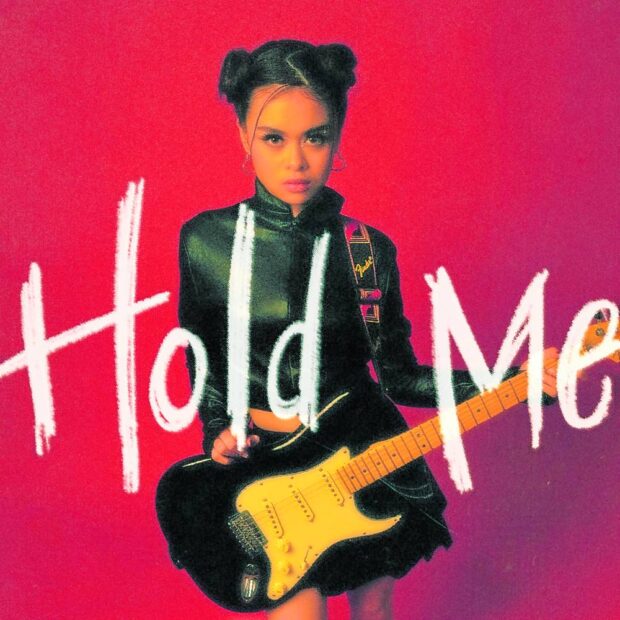Esang de Torres: From theater kid to rocker teen

Esang de Torres —POLYEAST RECORDS
As a product of “The Voice Kids Philippines,” Esang de Torres admitted that there was a point in her life when she felt the weight of people’s expectations.
“Honestly, I had thoughts that maybe people had expectations of me, that I should have already built on who I was or what I had shown before. But I don’t want to dwell on that anymore. I just want to focus on what I’m really passionate about,” she said at a recent press conference for her new single, “Hold Me” (PolyEast Records).
Esang finished third in the second season of “The Voice Kids PH,” whose final lineup included Kyle Echarri, Zephanie Dimaranan and eventual winner, Elha Nympha. The first season, meanwhile, produced Zack Tabudlo, Juan Karlos Labajo, Darren Espanto and Lyca Gairanod.
While comparisons are inevitable, Esang—now a precocious 16-year-old artist—understands that not everyone follows the same path or will have the same journey. “I just remind myself that I’m different and that the meaning of success can be subjective. I can say that I’m successful because I’m able to write songs and I’m with a record label that supports my work.”
Because of her excellence in performing Broadway pieces, the then 8-year-old Esang was dubbed a “mini-me” of her coach-mentor Lea Salonga.
Article continues after this advertisement
‘Hold Me’ cover art –POLYEAST RECORDS
Explore more genres
In 2016, she was cast by renowned theater producer Cameron Mackintosh as Little Cosette in a Manila staging of “Les Misérables.” The following year, she played the title role in “Matilda the Musical.”
Article continues after this advertisementBut while she still has a deep love and appreciation for ballads and other similar musical styles, she’s now more open to exploring and going beyond what people originally knew her for.
“Before, I would just perform pop songs and show tunes from Broadway musicals. This time, I plan to explore more genres and be diverse about the things I want to produce and how I want my music to sound like,” she said.
Her latest song, “Hold Me,” for instance, has echoes of early- to mid-2000s pop-rock.
“Aside from listening to songs from ‘Miss Saigon’ and ‘Les Misérables,’ I also loved listening to rock music as a child. My father was a band vocalist, and I would always listen when he played The Beatles and Elvis Presley. But my favorite is Queen … I also love Arctic Monkeys,” Esang said.
One of the challenges many child singers face as they grow older and undergo puberty is the gradual change in vocal quality. But while hitting high notes has become more challenging, the new emerging textures in her voice has made experimenting with other genres more fun and interesting.
“My voice is still changing and developing, so I want to try as many things as possible. There are songs and notes I can’t reach with the same ease I had when I was younger, but hitting low notes has become easier. I’m also compelled to learn or utilize different singing techniques. I play with my head tone and falsetto,” she said.
“In ballads, there’s more emphasis on vocal dynamics. But with pop-rock songs, you can put more angst to your voice and it’s all about the storytelling,” added Esang, whose previous single, “Mula Noon Hanggang Ngayon,” has been nominated for best ballad recording in the upcoming Awit Awards.
“Hold Me” is a bouncy anthem about being torn between holding on and letting go. “It’s a battle between the mind and the heart,” Esang said. “Everything is complicated at first, especially when you don’t know how to handle the situation… But eventually, you find yourself agreeing with the choices you make.”
As a songwriter, Esang’s goal is to come up with songs that people can relate to. “I want them to be open to personal interpretations; I want them to be able to relate the songs with their experiences,” said Esang, who considers “writing songs an emotional outlet.”
“I draw inspiration from my own thoughts and write about them. Writing songs is an outlet for my emotions—I want to make art out of these emotions instead of just letting them linger,” she said.
For Esang, songwriting is an indispensable facet of her craft. As a child, she often wondered what it felt like performing songs based on her own experiences. “When I was 12, I discovered that I could write poems… My friends and parents took notice of it. And since I’m already a singer, I thought, ‘Why not combine both?’ she said.
“Back then, I would sing songs that weren’t mine and wondered what it was like to have my own songs. Now, I have that privilege,” Esang said. “And I can say that the emotions really come out more.”